Abstract
The rate of reproduction of deep-sea bacteria from six different capture depths between 1957 and 10,476 meters was studied as a function of temperature and pressure. The results showed the following: the true deep-sea bacteria of different depths have several characteristics, presumably evolutionally derived, distinguishing them from each other and from bacteria of atmospheric-pressure environments; pressure plays a significant role in determining the distribution of oceanic life; and pressure-adapted bacteria are easily recovered from and ubiquitous in the deep ocean. Organisms evolving in habitats of different temperatures and pressures need to be studied to understand the physical limits of life, the distribution of life within the earth and its oceans, the role of organisms in organic diagenesis and petroleum formation, and the possible existence of life on and within other planets.
Keywords: high pressure, psychrophily, reproduction rates
Full text
PDF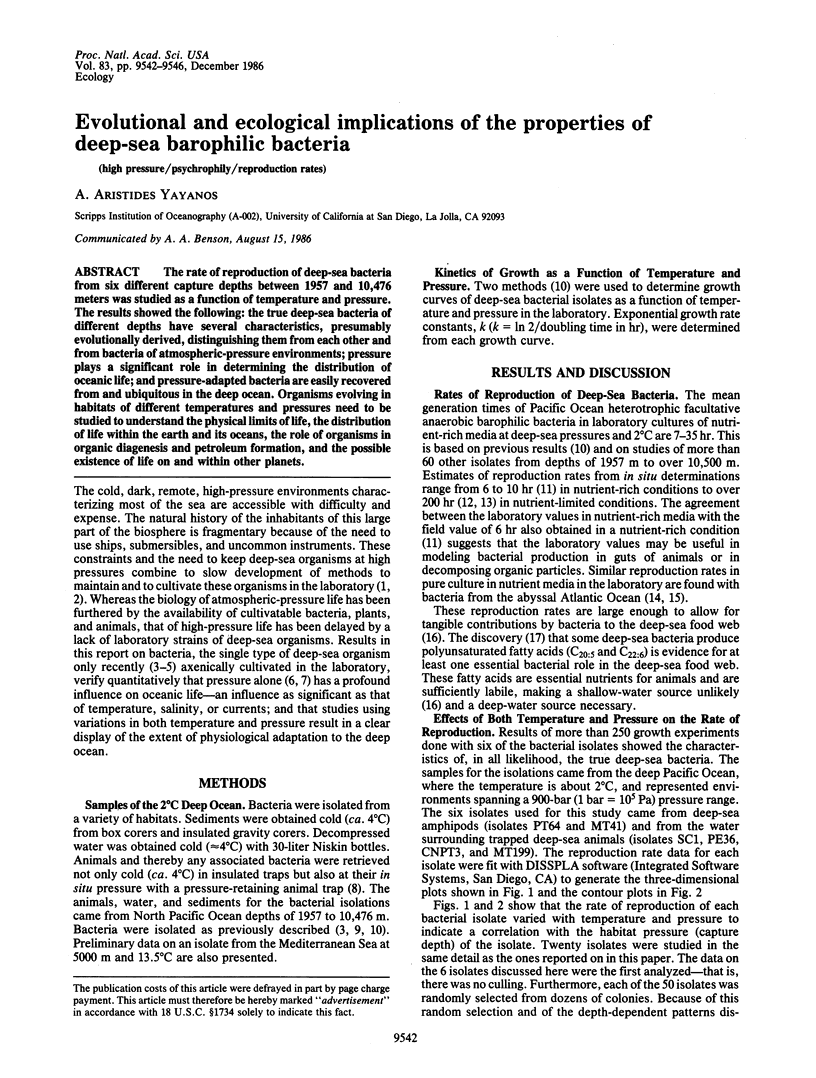
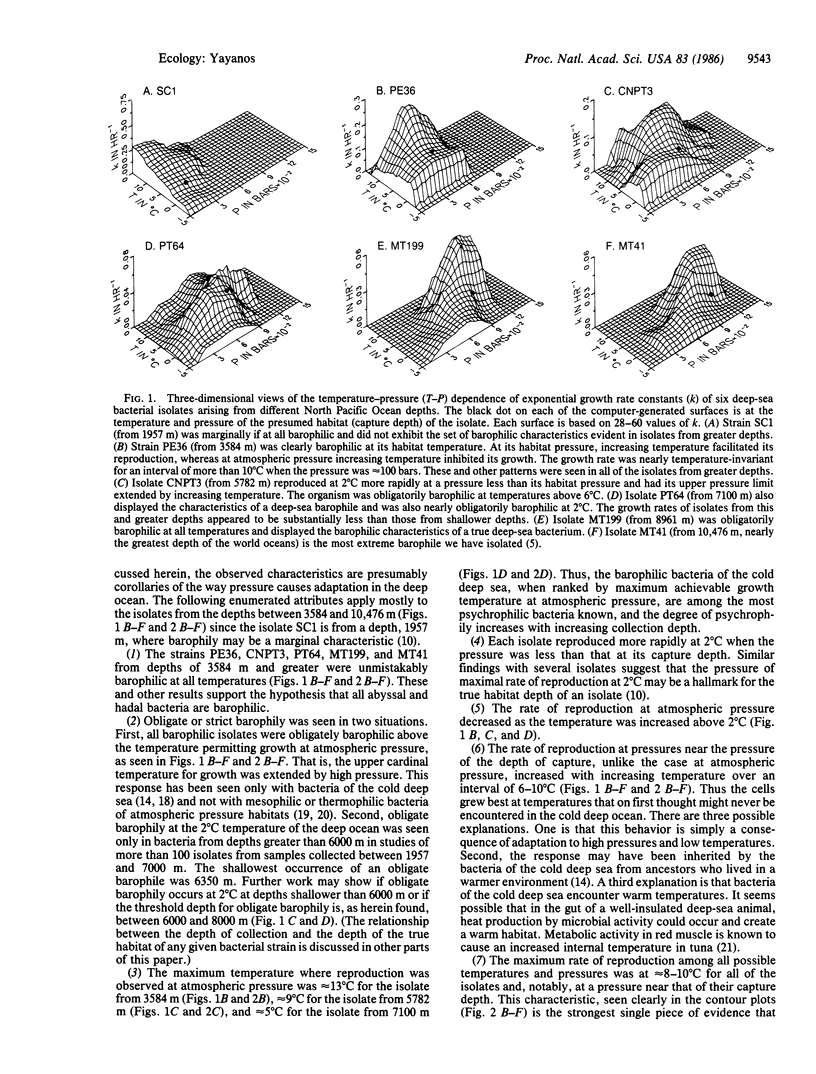
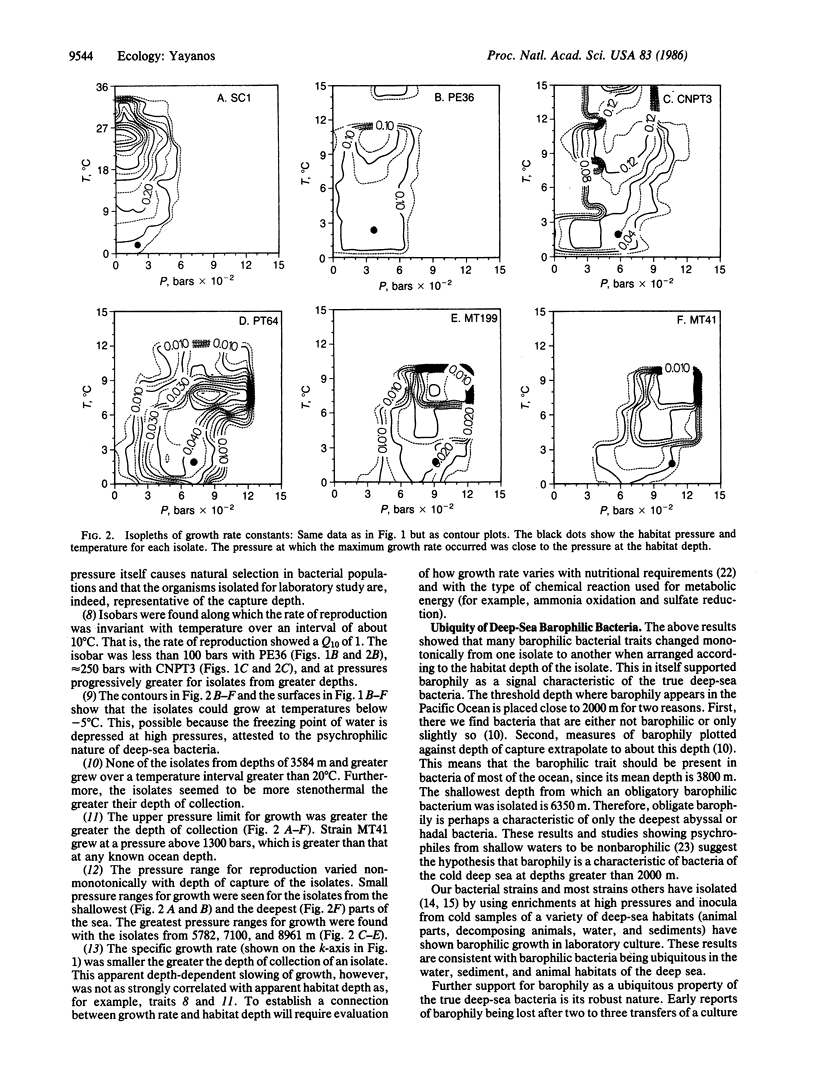
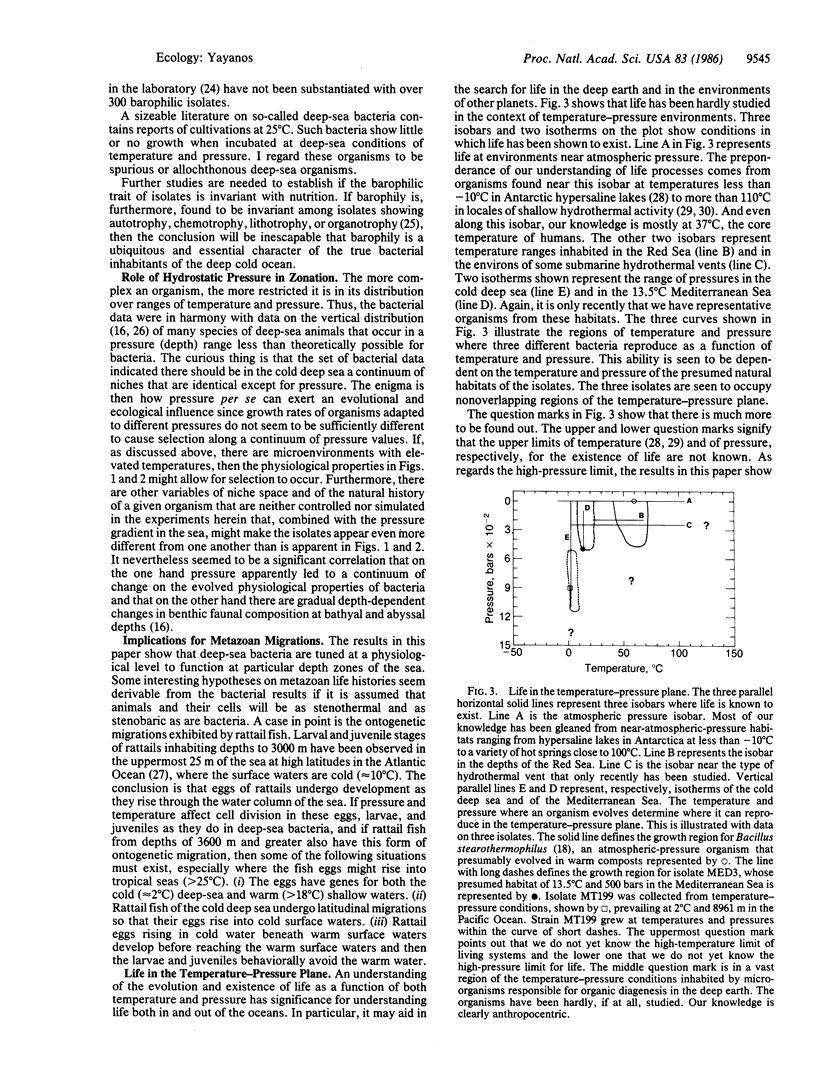
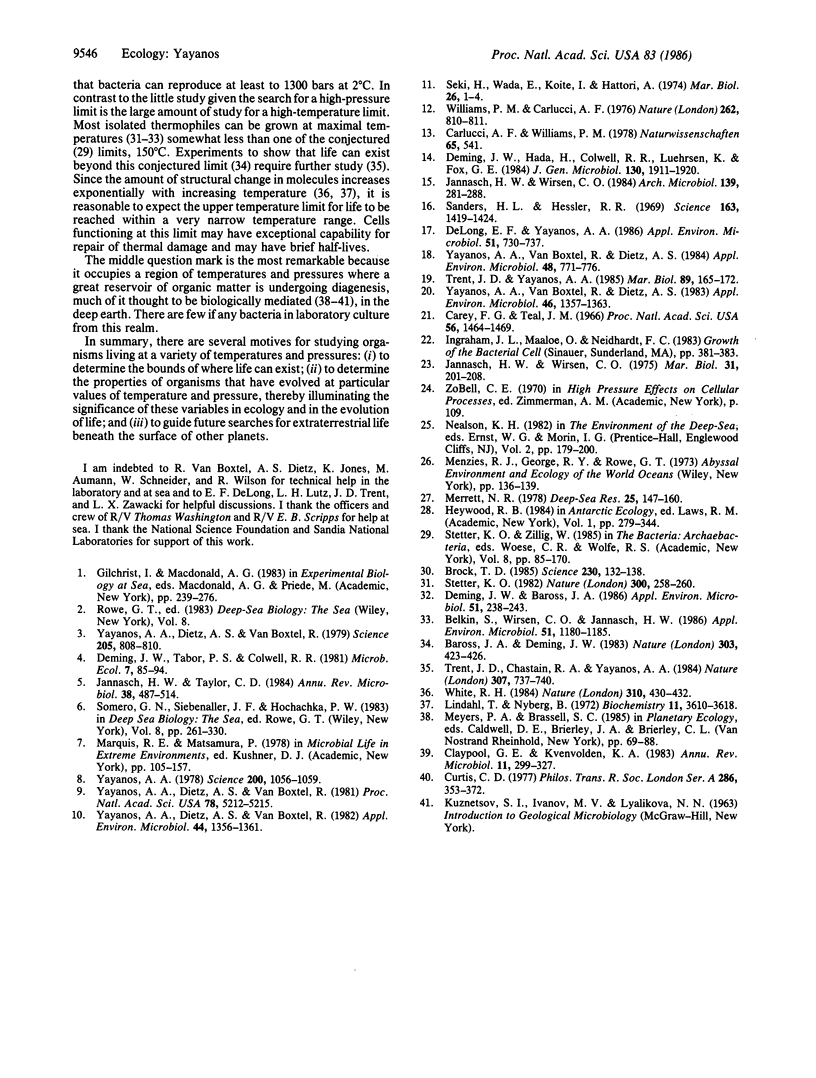
Selected References
These references are in PubMed. This may not be the complete list of references from this article.
- Belkin S., Wirsen C. O., Jannasch H. W. A new sulfur-reducing, extremely thermophilic eubacterium from a submarine thermal vent. Appl Environ Microbiol. 1986 Jun;51(6):1180–1185. doi: 10.1128/aem.51.6.1180-1185.1986. [DOI] [PMC free article] [PubMed] [Google Scholar]
- Brock T. D. Life at high temperatures. Science. 1985 Oct 11;230(4722):132–138. doi: 10.1126/science.230.4722.132. [DOI] [PubMed] [Google Scholar]
- Carey F. G., Teal J. M. Heat conservation in tuna fish muscle. Proc Natl Acad Sci U S A. 1966 Nov;56(5):1464–1469. doi: 10.1073/pnas.56.5.1464. [DOI] [PMC free article] [PubMed] [Google Scholar]
- Delong E. F., Yayanos A. A. Biochemical function and ecological significance of novel bacterial lipids in deep-sea procaryotes. Appl Environ Microbiol. 1986 Apr;51(4):730–737. doi: 10.1128/aem.51.4.730-737.1986. [DOI] [PMC free article] [PubMed] [Google Scholar]
- Deming J. W., Baross J. A. Solid Medium for Culturing Black Smoker Bacteria at Temperatures to 120 degrees C. Appl Environ Microbiol. 1986 Feb;51(2):238–243. doi: 10.1128/aem.51.2.238-243.1986. [DOI] [PMC free article] [PubMed] [Google Scholar]
- Deming J. W., Hada H., Colwell R. R., Luehrsen K. R., Fox G. E. The ribonucleotide sequence of 5s rRNA from two strains of deep-sea barophilic bacteria. J Gen Microbiol. 1984 Aug;130(8):1911–1920. doi: 10.1099/00221287-130-8-1911. [DOI] [PubMed] [Google Scholar]
- Jannasch H. W., Taylor C. D. Deep-sea microbiology. Annu Rev Microbiol. 1984;38:487–514. doi: 10.1146/annurev.mi.38.100184.002415. [DOI] [PubMed] [Google Scholar]
- Lindahl T., Nyberg B. Rate of depurination of native deoxyribonucleic acid. Biochemistry. 1972 Sep 12;11(19):3610–3618. doi: 10.1021/bi00769a018. [DOI] [PubMed] [Google Scholar]
- Sanders H. L., Hessler R. R. Ecology of the deep-sea benthos. Science. 1969 Mar 28;163(3874):1419–1424. doi: 10.1126/science.163.3874.1419. [DOI] [PubMed] [Google Scholar]
- Trent J. D., Chastain R. A., Yayanos A. A. Possible artefactual basis for apparent bacterial growth at 250 degrees C. Nature. 1984 Feb 23;307(5953):737–740. doi: 10.1038/307737a0. [DOI] [PubMed] [Google Scholar]
- White R. H. Hydrolytic stability of biomolecules at high temperatures and its implication for life at 250 degrees C. Nature. 1984 Aug 2;310(5976):430–432. doi: 10.1038/310430a0. [DOI] [PubMed] [Google Scholar]
- Williams P. M., Carlucci A. F. Bacterial utilisation of organic matter in the deep sea. Nature. 1976 Aug 26;262(5571):810–811. doi: 10.1038/262810a0. [DOI] [PubMed] [Google Scholar]
- Yayanos A. A., Dietz A. S., VAN Boxtel R. Isolation of a deep-sea barophilic bacterium and some of its growth characteristics. Science. 1979 Aug 24;205(4408):808–810. doi: 10.1126/science.205.4408.808. [DOI] [PubMed] [Google Scholar]
- Yayanos A. A., Dietz A. S., Van Boxtel R. Dependence of reproduction rate on pressure as a hallmark of deep-sea bacteria. Appl Environ Microbiol. 1982 Dec;44(6):1356–1361. doi: 10.1128/aem.44.6.1356-1361.1982. [DOI] [PMC free article] [PubMed] [Google Scholar]
- Yayanos A. A., Dietz A. S., Van Boxtel R. Obligately barophilic bacterium from the Mariana trench. Proc Natl Acad Sci U S A. 1981 Aug;78(8):5212–5215. doi: 10.1073/pnas.78.8.5212. [DOI] [PMC free article] [PubMed] [Google Scholar]
- Yayanos A. A. Recovery and maintenance of live amphipods at a pressure of 580 bars from an ocean depth of 5700 meters. Science. 1978 Jun 2;200(4345):1056–1059. doi: 10.1126/science.200.4345.1056. [DOI] [PubMed] [Google Scholar]
- Yayanos A. A., Van Boxtel R., Dietz A. S. Reproduction of Bacillus stearothermophilus as a Function of Temperature and Pressure. Appl Environ Microbiol. 1983 Dec;46(6):1357–1363. doi: 10.1128/aem.46.6.1357-1363.1983. [DOI] [PMC free article] [PubMed] [Google Scholar]
- Yayanos A. A., van Boxtel R., Dietz A. S. High-pressure-temperature gradient instrument: use for determining the temperature and pressure limits of bacterial growth. Appl Environ Microbiol. 1984 Oct;48(4):771–776. doi: 10.1128/aem.48.4.771-776.1984. [DOI] [PMC free article] [PubMed] [Google Scholar]


